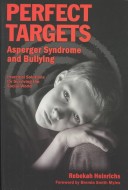Everybody is familiar with the classic poem by Ernest Lawrence Thayer, “Casey at the Bat,” first published in 1888 in the San Francisco Examiner. That’s 120 years ago. According to Wikipedia, Thayer was “so embarrassed by what he considered to be a doggeral that he kept his identity secret for years.” It was originally published under a pen name.
As a reminder, the poem begins:
“The outlook wasn’t brilliant for the Mudville nine that day:
The score stood four to two, with but one inning more to play,
And then when Cooney died at first, and Barrows did the same,
A pall-like silence fell upon the patrons of the game.
A straggling few got up to go in deep despair. The rest
Clung to the hope which springs eternal in the human breast;
They thought, “If only Casey could but get a whack at that–
We’d put up even money now, with Casey at the bat.”
The poem has certainly endured. Each spring, like mushrooms after a rain, new picture book versions of Thayer’s classic poem seem to arrive in our libraries, each more fabulously illustrated than the next. And no offense to these talented illustrators, but Casey grows increasingly steroidal. For example:
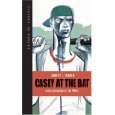


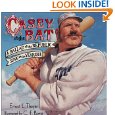
Yet as much as I liked the original poem, it never seemed to hold a lot of kid appeal. So the idea struck me that I could do my own version of the poem, keeping the baseball flavor and dramatic setup, but transposing it to a Little League field at the youngest, most inept, most playful level.
Thus, Mighty Casey (Feiwel & Friends, March, 2009), a decidedly different take.
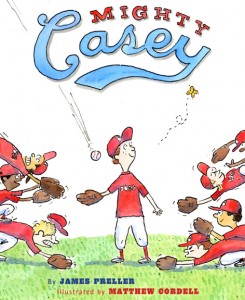
I got the idea for this translocation directly from my years of Little League coaching. I’ve spent a lot of time with those kids. Here’s a recent snap from last September. That’s my Maggie, at age seven. Maggie’s state of readiness is impressive, particularly when compared to her teammate in centerfield.

I wrestled with the text for several months, going down various dead ends. In fact, the poem was saved when my editor, Liz Szabla, performed an intervention. Really, some of those early drafts were awful; a textbook case of a book being salvaged by a few, select, insightful comments from an editor. Fortunately, all anyone reads is the final result. In the end, my re-imagined version retained Thayer’s basic rhyme scheme, but broke the long lines in half. It begins:
“The outlook wasn’t brilliant
for the Delmar Dogs that day.
All summer long, the Dogs
lost every game they played.
Yes, it’s true, the Dogs had guts,
and the Dogs had heart;
but catching the baseball, well,
that was the hardest part.”
Once approved by Jean and Liz at Feiwel & Friends, it was time for the artwork. The name they came up with was a new one to me, some fellow named Matthew Cordell. I looked him up and immediately liked his style. I saw that his illustrative approach was light and accessible. I thought that he could really bring out the humor in the piece. But I was wrong about that. Matthew made it funnier, better. I’ve been lucky. While Matthew’s artwork may not be the most technically rendered, he has a feeling for children’s books, a warmth, and his work connects with young readers. Whatever it is, that special quality, Matthew has it. Here’s one sample of his artwork from the book: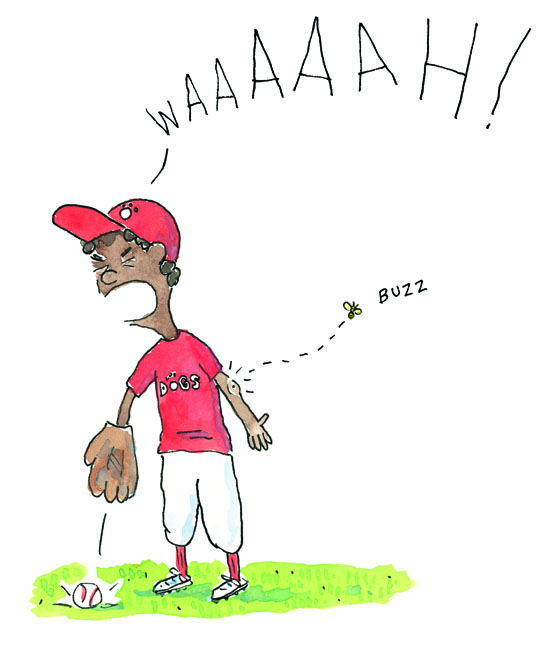
Ashanti fell fast asleep;
Tommy Maney climbed a tree.
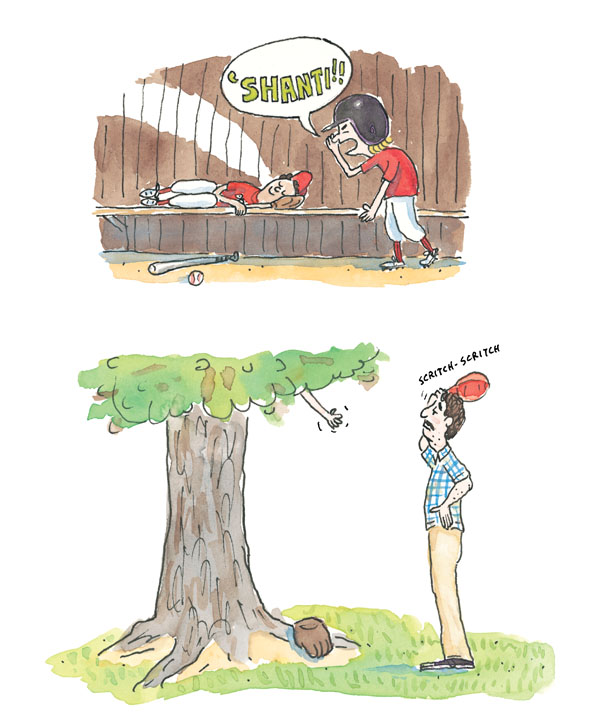
And, okay, twist my arm, here’s another few lines from the book:
Bloopers, flubs, drops, and blunders —
the Dogs could do nothing right.
Still Casey declared, “We won’t
surrender without a fight!”
–
When Jinn Lee clubbed a homer,
the fans stood and cheered.
The Dogs scored at last.
Said Lee, “That’s, like, sooo weird.”
Don’t you love that rhyme, cheered and weird? Thank you, thank you very much. Anyway, it’s freezing outside. Eight degrees, last I looked. But pitchers and Molinas report to Spring Training in less than a month. Breathe deep. Can’t you feel it? Baseball is around the corner. And Mighty Casey is due to arrive in bookstores March 3rd. Play ball. We’re swinging for the fences!










